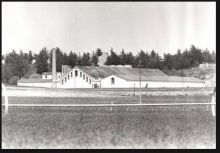RAÏMAT
Name of the station: Raïmat.
Date of inauguration: 1863
Author: Isabel Rivera
Origin and evolution
Raïmat was an agricultural settlement prior to the Guerra dels Segadors (“Reapers’ War” of 1642). After this conflict, the village remained abandoned for over 270 years.
The railway station of Almacelles, which connected Raïmat to Lleida and Zaragoza, was inaugurated in 1863.
In 1914, Don Manuel Raventós Domènech acquired the Raïmat estate for a winemaking project. There were three main reasons why Raventós decided to buy this property: the recent opening of the Catalonia and Aragón Canal; the transport link provided by the road running between Lleida and Huesca; and Raïmat railway station, where all the small trains stopped in compliance with an agreement with the company Ferrocarriles del Norte de España[i]. During the period between 1921 and 1945, the main use of the railway station was related to agriculture and industry.
On 6th June 1988, Raïmat opened a new wine cellar. This last great transformation was a response to increased production and gave a major boost to wine production at Raïmat.
The current situation:
Raïmat is a very small village and is currently considered a decentralised body within the municipality of Lleida. It is located in the comarca (local district) of El Segriá, in the province of Lleida (in the Autonomous Community of Catalonia). It currently has 480 inhabitants, with 252 men and 228 women.
The village has a railway station on the Barcelona-Manresa-Lleida-Zaragoza line, which is still in service.
However, Raïmat station has lost the relevance that it had during the first half of the 20th century and no longer has regular services. The main problem is that the railway station is located outside the main nucleus of Raïmat (figure 1) and does not have the infrastructure required to provide passenger services.
Figure 1: The railway station and the municipality of Raïmat.

Source: Archive of the Institut Cartogràfic de Catalunya
The Raïmat wine cellars are a very important tourist attraction. They offer guided visits and wine tasting courses and also rent spaces for a variety of events.
Special features:
Raïmat also has other relevant heritage. For example, it has two wine cellars. The first of these was built between 1916 and 1918 (figure 2) under the supervision of the architect Rubió i Bellver who had trained in the workshops of Antoni Gaudí. This is quite an austere Catalan Modernist (Art Nouveau) building. The new cellar was the work of the architect Domingo Triay. It incorporated a modern design, based on straight lines, with glass as the main material, thus providing a contrast with the Art Nouveau design of the old cellar.
Figure 2: The first Raïmat wine cellar, 1918.
Source: www.raimat.org
The village church, which is called the “Sagrat Cor” or Sacred Heart (figure 3), was constructed by the same architect and consecrated in 1922.
Figure 3: The Church of the Sacred Heart.
Source: www.raimat.org
The heirs of Manuel Raventós donated some of their land to the Jesuit Order for the construction of the school what is now known as “Col·legi Claver “.
Epilogue:
At present, there are no plans to reopen the railway station, nor any need for it, as the demand for transport to the village is very limited. Even so, there are a number of good reasons for visiting the village.
Firstly, it has great tourist potential thanks to its architectural, natural and cultural heritage. Its architectural heritage includes its wine cellars, church and Jesuit school. Its natural heritage includes the local vineyards and is complemented by the local winemaking tradition and culture.
[i] Railways of the North of Spain
